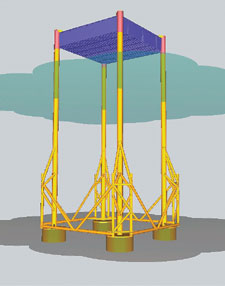 |
the Netherlands |
|
Mobile offshore barge for UK North Sea
Keppel Verolme (KV) was contracted by Perenco UK Ltd. to design and construct, in accordance with UK legislation, a Mobile Offshore Application Barge (MOAB). The operator is a subsidiary of Perenco SA, one of Europe’s largest independent exploration and production companies, producing about 200,000 boepd net worldwide.
 |
Mobile Offshore Application Barge (MOAB) for UK North Sea.
|
|
The self-installing platform, planned for August 2005 installation, will be used as an unmanned gas compression platform adjacent to, and connected with a bridge link, to Perenco’s existing production platform at the Trent field development on the UK North Sea Continental Shelf.
The North Sea is Europe’s main oil/gas producing area, and its large reserves make it a key supplier of European gas. To curb impending dependence on hydrocarbon imports, the UK government has implemented new policies to encourage entry of independents to improve production in this region. KV contracted Overdick Gmbh & Co. KG to perform basic design and detailed engineering. Detailed fabrication engineering is done using TRIBON.
The MOAB is a self-installing platform, enabling the operator to transport and install it on location, roughly halfway between England and the Netherlands on the UK CS, in water depth of 159 ft (48.6 m), without use of a heavy offshore construction vessel. This proven platform design allows for multiple relocations during its operational life; it has also been constructed for two fields in Malaysia for Talisman.
Further system advantages include:
- Low-cost relocation using the reversed suction operation to float free from the seafloor
- Temporary strand jack system on rental basis
- Hull construction based on standard shipbuilding technology
- Topsides are fully installed and pre-commissioned before float-out
- Economic decommissioning/ re-use.
Assembly of the hull with the substructure and suction piles will be done in dry dock. The hull will be placed on a special dock block arrangement, allowing the legs with suction cans to be erected from a horizontal position into vertical. The hull will be connected in the lower position to provide buoyancy during float-out.
After un-docking and shifting afloat to a suitable quayside, the MOAB will be outfitted with Perenco-supplied gas compressors and process package by the KV labor force. The MOAB is designed for 100-yr storm conditions with 900-mt payload.
MOAB uses a temporary lifting system (strand jack) to lower the legs to the seabed and elevate the hull main deck to the required level above sea surface. Then “super bolts” replace the temporary lifting system and clamps make connection of hull to substructure. The foundation is achieved by use of suction piles. Future removal and relocation is based on the reversed operation.
The MOAB hull is self-floating with the substructure attached. The four braced legs are pre-installed connected to the hull. The legs have a 2-m OD and are braced underwater and supported on suction piles. Construction of the tubulars for the substructure started in last-quarter 2004 – hull and suction piles were progressing ahead of schedule in early 2005. 
|




